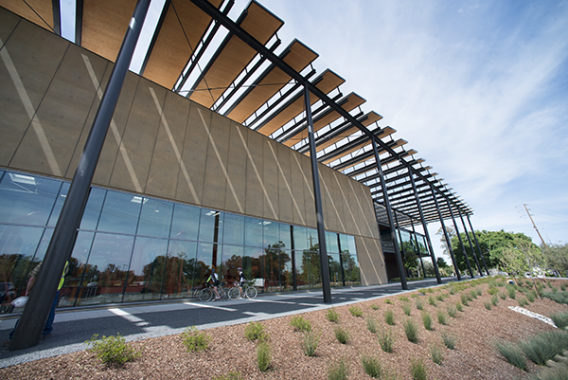by Brianna Crandall — April 21, 2017 — The American Institute of Architects (AIA) Committee on the Environment (COTE) has just announced this year’s recipients of the Top Ten Awards, the industry’s premier program celebrating sustainable design excellence. Now in their 21st year, the Top Ten Awards highlight projects that exemplify the integration of great design and great performance. Submissions are required to demonstrate how the project aligns with COTE’s rigorous criteria for social, economic, and ecological value. The recipients will be honored at the 2017 AIA Conference on Architecture in Orlando.

The Stanford University Central Energy Facility replaces a 100-percent-fossil-fuel-based cogeneration plant with primarily electrical power — 65 percent of which comes from renewable sources. Photo courtesy of Stanford
New for 2017
For this year, COTE substantially revised its Measures of Sustainable Design, the criteria judges use to evaluate projects. New topics include impact on health, wellness, and the economy / cost-effectiveness, as well as resilience. Judges see the beginnings of a positive focus on health and wellness, and encourage architects to continue the emphasis on a rigorous, holistic sustainability.
In past years, judging was based largely on predicted performance, not actual performance as measured after occupying the buildings. Since 2014, past Top Ten recipients have been invited to submit post-occupancy data and narratives. Starting in 2017, the COTE Top Ten Plus award — which previously recognized a single project from the pool of previous COTE Top Ten award recipients — has now become a designation among the Top Ten projects that demonstrates exceptional post-occupancy performance and lessons learned. This year’s Top Ten Plus honor went to Brock Environmental Center, Virginia Beach, VA, by SmithGroupJJR.
Judges noted that, although ten years ago the focus was on attaining LEED certification, this year’s applicants followed a diversity of programs and paths to sustainability, and numerous applicants had attained Zero Net Energy status, sometimes for less cost than regular buildings.
Achievements
Some of the projects’ achievements include:
- The first Zero Net Energy academic science building in the Northeast;
- Achieving zero-net-CO2 emissions, zero waste, and Living Building Challenge certification;
- The world’s first net-positive campus, generating more energy than it uses;
- The largest zero-energy school in the USA;
- A self-sustaining building that generates its own energy, captures its own water, and processes its own waste; and
- A central energy facility using a first-of-its-kind heat recovery system.
The projects have such features as green roofs and an extensive use of renewable energy, and several use building design to promote the health and fitness of occupants and to embed core public health values — movement, light/air, greenery, connection to place, social interaction and community engagement.
The 2017 Top Ten Award recipients are:
- Bristol Community College John J. Sbrega Health and Science Building, Fall River, MA; Sasaki
- Brock Environmental Center, Virginia Beach, VA; SmithGroupJJR (Top Ten Plus)
- Chatham University Eden Hall Campus, Richland Township, PA; Mithun
- Discovery Elementary School, Arlington Public Schools, Arlington, VA; VMDO Architects
- Manhattan Districts 1/2/5 Garage and Spring Street Salt Shed, New York City, NY; Dattner Architects and WXY architecture + urban design
- Milken Institute School of Public Health, George Washington University, Washington, DC; Payette and Ayers Saint Gross
- Ng Teng Fong General Hospital and Jurong Community Hospital, Singapore; HOK, USA; CPG, Singapore; Studio 505, Australia
- NOAA Daniel K. Inouye Regional Center, Honolulu, HI; HOK with Ferraro Choi & WSP
- R.W. Kern Center, Amherst, MA; Bruner/Cott & Associates
- Stanford University Central Energy Facility, Stanford, CA; ZGF Architects LLP
Photos of the winning projects and details about their sustainable design initiatives are available on the 2017 COTE Top Ten Web page.
In a recent statement, AIA urged policymakers to keep carbon-neutral goals for the built environment.




